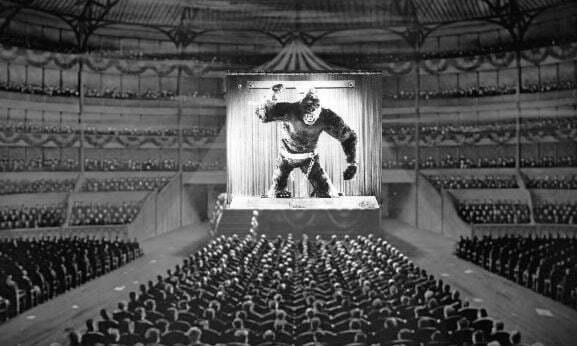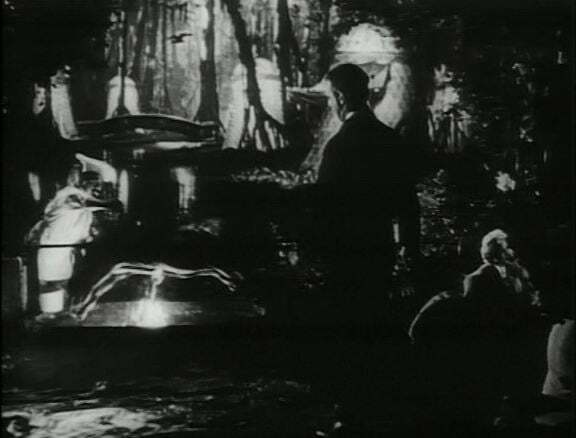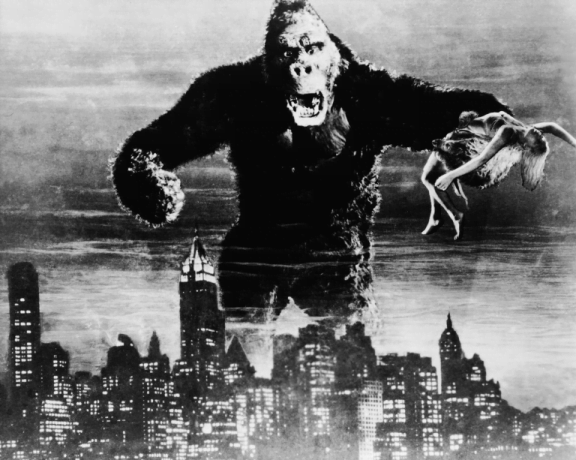
Have you seen the pterodactyls in Citizen Kane? They are there, supposedly, in the background of the beach picnic scene towards the end of the film. As the camera tracks through the party guests, following Kane’s butler Raymond (played by Paul Stewart), just before we enter the Kanes’ tent, there in the background are silhouettes of flapping bird-like creatures, seen briefly flying through the trees, perhaps unexpected members of the famed Kane menagerie.
Many lovers of obscure film trivia hold that they are back-projected images of a jungle with pterodactyls taken from another film, Song of Kong (1933). Doubt has been cast on this, as no shot from the 1933 film matches that in Kane, but Citizen Kane, Song of Kong and King Kong (also 1933), of which Song of Kong was a quickie sequel, shared the same background artist, Mario Larrinaga. So we can keep on speculating. At any rate, viewing the sequence while watching Citizen Kane the other day, for the umpteenth time, made me think of King Kong. What might be the greater connection between King Kong and Citizen Kane? Might they be, in some peculiar way, the same film?

Let us consider first the obvious connections.
Both films tell a story of a larger-than-life figure who comes crashing down to earth.
Both are among the most iconic of all films, films whose primary images are an essential part of any visual overview of film history.
Both films were made by RKO Radio Pictures and can be argued as being the twin major highlights of the studio’s output, produced at either end of a golden decade of Hollywood film production.
Both films were signature productions of producers whose towering presence might be read into the subject matter of either film. King Kong was one of the last films green-lighted by David O. Selznick, during his brilliant short run as Head of Production at RKO. Eight years on,

The titles of both films make prominent use of the letter K. There’s something about K, as there is with Q, X and Z, those unusual, arresting letters that writers and filmmakers have used to denote the commanding and otherworldly. K points to a German-American inheritance (the Katzenjammer Kids), to brutal passions (the Ku Klux Klan), to Kings – a letter that stands high on two legs, with arms stretched out over us: like Kane, like Kong.
Both films could be titled, or subtitled, ‘Beauty and the Beast’. Carl Denham (played by Robert Armstrong), the explorer-filmmaker in King Kong, revels in the phrase that will sell his story. King Kong is brought down, literally, by his love for Ann Darrow (played by Fay Wray). At the end of the film, after Kong has been shot down from the top of the Empire State Building by warplanes, a policeman says, “Gee, what a sight. Well, the aiplanes got him.”. Denham corrects him: “Oh no, it wasn’t the airplanes – it was Beauty killed the Beast”. Citizen Kane is no less the story of greatness felled by beauty, Kane having the world in his hands, a step or two away from the presidency, only to be humbled by his love for Susan Alexander (Dorothy Comingore). He loses power in pursuit of that he feels he must possess. It is Susan, not the silly red herring of ‘Rosebud’, that is the thing Kane “couldn’t get or lost”, as the reporter Thompson (William Alland) says near the end of the film.

Digging deeper, both films have a tragic dimension and structure. They tell of a heroic figure whose underlying flaw leads to a terrible fall. We, the humble audience, recognise these powerful things while being unable to know fully what brings about the end of one whose greatness makes them not as others are. Of course, the protagonists are very different in the roles that they play. Kane is, in part, the engineer of his own destiny. Kong is all victim – he has no inner tragic flaw. But tragedy, as defined by Aristotle, is about the arousing of pity and fear. It is what the audiences feels that makes for tragedy. We see both brought down through what they cannot help but be. Kong and Kane are different but complementary tragic figures.
Although Citizen Kane is a far more complex film structurally than the linear King Kong, both can be viewed as following a classical tragic drama format. The five-act structure that the Jacobean dramatists learned from Seneca can be found first in King Kong, the succession of settings mirroring the development of the tragedy. Using Gustav Freytag’s pyramidal shaping of Western dramatic structure, we have:
- Exposition – Denham plans a secret voyage to an island, discovering the actress he needs in Ann Darrow’s New York waif
- Complication – the filmmakers travel from the known to the unknown, landing at Skull Island, where Ann is kidnapped by the natives
- Climax – Denham and the ship’s crew head into the island to rescue Ann from Kong. Most die, but first mate Driscoll (Bruce Cabot) saves her and Kong, enraged that Ann has been taken from him, is captured
- Fall – Kong is presented in chains before an incredulous Broadway audience, then breaks free when he thinks Ann is threatened
- Catastrophe – Kong, having climbed to the top of the Empire State Building while carrying Ann, sets her down before planes shoot him and he falls to earth
Citizen Kane, with its deconstruction of linear narrative, is the polar opposite of King Kong as cinematic experience. Nevertheless, when we look back on the tale that has been told, what has unfolded breaks down in similar fashion:
- Exposition – Thanks to a mining deed held by his mother, the young Charles Foster Kane inherits a fortune and is brought up by guardians
- Rise – Kane spends lavishly, then decides to concentrate his attentions on running a newspaper. He becomes famous, influential and ambitious
- Climax – Kane believes himself to be unstoppable. But while running for the governorship of New York, Kane starts an affair with Susan Alexander, which is exposed by his opponent, leading to the end of his political ambitions
- Fall – Kane tries but fails to turn Alexander into an operatic star, unable to understand the limits of his power
- Catastrophe – Susan leaves Kane. He retreats from the world at his palace, Xanadu, obsessed with collecting, dying surrounded by things but alone
What engineers their fall is similar for both Kong and Kane. Each is brought down through the media. Firstly, each film is structured around the production of a film. Denham is a Paul J. Rainey-like figure, filming wildlife is exotic locations with aim of making exciting films for audiences to view from the safety of their cinema seats. The trip to Skull Island will be his greatest adventure, Ann his petrified heroine. He goes on to make Kong a theatrical exhibit, but this scarcely matters (indeed it could be that showing Kong on stage is a stunt designed to raise publicity for the film he has made).
Citizen Kane is framed by the making of a newsreel in the manner of The March of Time. Thompson, the reporter, is sent to find out more about Charles Foster Kane, because the newsreel we see at the start of the film tells us nothing about motivation. That Thompson, ostensibly working for a newsfilm company, has no camera with him and would appear to be preparing a magazine profile, is one of Citizen Kane’s unexplained oddities, but the petty matter is not important. The feature film that unfolds is the newsreel promised to us by his quest. Both Kong and Kane become the films that their fictional progenitors dreamed that they might be.
The role played by the media in each film is therefore established at the start, self-reflexively determining their shape and outcome. Film is but one medium, and by ‘media’ we should understand all those mechanisms by which stories of the great are transmitted to the small. In King Kong, there is literally a trigger moment, when Kong is chained in front of the Broadway audience. The flash of the press photographers’ cameras Kong interprets as an attack on Ann, causing him to break free and run amok through the city. Kane’s flash moment is when the ‘love nest’ story is broken in the newspapers, leading to defeats in the polls and his decline as a figure with credible power. His fall is longer in duration than Kong’s, but at the end it is the press and their cameras that pore over the “loot of the world” that he has left behind him.

King Kong and Citizen Kane are products of their time. Each were creations of the period between the two world wars, when people looked for solutions to the crises that civilization apparently faced, by raising up new kinds of king. Figures rose up with all-encompassing ideologies: dictators, demagogues, egotists, supermen, Übermenschen. They saw the death of God and the fall of kings brought about by the First World War. They positioned themselves in the gap that they believed was there for them to fill. The media came to their aid, allowing for messages to be mass-circulated. The cinema provided the perfect realisation of their dreams, with its captive audience and the hypnotic figure on the screen, towering over them all, loved and feared and everlasting.
They missed the point, however. The audience was not the passive mass that they imagined it to be. It was looking for stories. It too had drawn lessons from the fall of kings. It knew that there had to be a rise and fall, a lesson to be learned, and then the curtain would close until it was time for the next show. The supermen did not own the story; the audience did. Some in that audience believed such stories for a while, of course, but they were just stories and all stories must have an end. The time of kings was past. The real, underlying story was that power was drifting to the mass, to the people in those cinema seats, whom the media were there to serve. It is that change in power relations which brings down both Kong and Kane. They grew too big for their democratic times. It was not beauty who killed the beast; it was we the people who pulled it down.
King Kong and Citizen Kane are both about the fall of monsters. As Shakespeare might have advised, both tell sad stories of the death of kings. That we pity Kong but not Kane (has anyone ever felt sorry for Charles Foster Kane, even when we think about the loss of his childhood?), may make King Kong the greater film. It is pure myth, the emblematic story of our times.
Links:
- David Cairns, in his Shadowplay blog, meticulously debunks the Song of Kong pterodactyls theory. He nevertheless keeps the mystery going by pointing out the linking role of matte artist Mario Larringa
- John Yorke’s Into The Woods: How Stories Work and Why We Tell Them includes an explanation of nineteenth-century German write Gustav Freytag’s ‘Pyramid’ concept of the five stages in any tragedy
- Both Citizen Kane and King Kong are available long-term on the BBC’s iPlayer. Those in the UK yet to see either have such a treat in store. Off you go…
Airplanes, not Aviators
You are quite right, of course. I have corrected the text. Thank you.